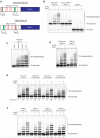Activation of the APC/C ubiquitin ligase by enhanced E2 efficiency
- PMID: 24930963
- PMCID: PMC4090254
- DOI: 10.1016/j.cub.2014.05.052
Activation of the APC/C ubiquitin ligase by enhanced E2 efficiency
Abstract
The anaphase-promoting complex/cyclosome (APC/C) is a protein-ubiquitin ligase (E3) that initiates the final events of mitosis by catalyzing the ubiquitination and proteasomal destruction of securin, cyclins, and other substrates [1, 2]. Like other members of the RING family of E3s [3, 4], the APC/C catalyzes direct ubiquitin transfer from an E2-ubiquitin conjugate (E2-Ub) to lysine residues on the protein substrate. The APC/C is activated at specific cell-cycle stages by association with an activator subunit, Cdc20 or Cdh1, which provides binding sites for specific substrate sequence motifs, or degrons. Activator might also stimulate catalytic activity [5, 6], but the underlying mechanisms are not known. Here, we dissected activator function using an artificial fusion substrate in which the N-terminal region of securin was linked to an APC/C core subunit. This fusion substrate bound tightly to the APC/C and was ubiquitinated at a low rate in the absence of activator. Ubiquitination of this substrate was stimulated by activator, due primarily to a dramatic stimulation of E2 sensitivity (Km) and catalytic rate (kcat), which together resulted in a 670-fold stimulation of kcat/Km. Thus, activator is not simply a substrate adaptor, but also enhances catalysis by promoting a more efficient interaction with the E2-Ub. Interestingly, full E2 stimulation required activator interaction with degron motifs on the substrate. We conclude that formation of a complete APC/C-activator-substrate complex leads to a major enhancement of E2 efficiency, providing an unusual substrate-assisted catalytic mechanism that limits efficient ubiquitin transfer to specific substrates.
Copyright © 2014 Elsevier Ltd. All rights reserved.
Figures




Similar articles
-
RING E3 mechanism for ubiquitin ligation to a disordered substrate visualized for human anaphase-promoting complex.Proc Natl Acad Sci U S A. 2015 Apr 28;112(17):5272-9. doi: 10.1073/pnas.1504161112. Epub 2015 Mar 30. Proc Natl Acad Sci U S A. 2015. PMID: 25825779 Free PMC article.
-
An E2 accessory domain increases affinity for the anaphase-promoting complex and ensures E2 competition.J Biol Chem. 2015 Oct 2;290(40):24614-25. doi: 10.1074/jbc.M115.678193. Epub 2015 Aug 25. J Biol Chem. 2015. PMID: 26306044 Free PMC article.
-
The APC subunit Doc1 promotes recognition of the substrate destruction box.Curr Biol. 2005 Jan 11;15(1):11-8. doi: 10.1016/j.cub.2004.12.066. Curr Biol. 2005. PMID: 15649358
-
Impressionist portraits of mitotic exit: APC/C, K11-linked ubiquitin chains and Cezanne.Cell Cycle. 2019 Mar-Apr;18(6-7):652-660. doi: 10.1080/15384101.2019.1593646. Epub 2019 Mar 28. Cell Cycle. 2019. PMID: 30874463 Free PMC article. Review.
-
Posing the APC/C E3 Ubiquitin Ligase to Orchestrate Cell Division.Trends Cell Biol. 2019 Feb;29(2):117-134. doi: 10.1016/j.tcb.2018.09.007. Epub 2018 Oct 25. Trends Cell Biol. 2019. PMID: 30482618 Free PMC article. Review.
Cited by
-
Regulation of OLC1 protein expression by the anaphase-promoting complex.Oncol Lett. 2019 Mar;17(3):2639-2646. doi: 10.3892/ol.2019.9881. Epub 2019 Jan 2. Oncol Lett. 2019. PMID: 30854039 Free PMC article.
-
Cyclin A2 degradation during the spindle assembly checkpoint requires multiple binding modes to the APC/C.Nat Commun. 2019 Aug 27;10(1):3863. doi: 10.1038/s41467-019-11833-2. Nat Commun. 2019. PMID: 31455778 Free PMC article.
-
The pseudosubstrate inhibitor Acm1 inhibits the anaphase-promoting complex/cyclosome by combining high-affinity activator binding with disruption of Doc1/Apc10 function.J Biol Chem. 2019 Nov 15;294(46):17249-17261. doi: 10.1074/jbc.RA119.009468. Epub 2019 Sep 27. J Biol Chem. 2019. PMID: 31562243 Free PMC article.
-
Degradation of FBXO31 by APC/C is regulated by AKT- and ATM-mediated phosphorylation.Proc Natl Acad Sci U S A. 2018 Jan 30;115(5):998-1003. doi: 10.1073/pnas.1705954115. Epub 2018 Jan 17. Proc Natl Acad Sci U S A. 2018. PMID: 29343641 Free PMC article.
-
WD40 domain of Apc1 is critical for the coactivator-induced allosteric transition that stimulates APC/C catalytic activity.Proc Natl Acad Sci U S A. 2016 Sep 20;113(38):10547-52. doi: 10.1073/pnas.1607147113. Epub 2016 Sep 6. Proc Natl Acad Sci U S A. 2016. PMID: 27601667 Free PMC article.
References
-
- Barford D. Structure, function and mechanism of the anaphase promoting complex (APC/C). Q. Rev. Biophys. 2011;44:153–190. - PubMed
-
- Deshaies RJ, Joazeiro CA. RING domain E3 ubiquitin ligases. Annu. Rev. Biochem. 2009;78:399–434. - PubMed
-
- Hayes MJ, Kimata Y, Wattam SL, Lindon C, Mao G, Yamano H, Fry AM. Early mitotic degradation of Nek2A depends on Cdc20-independent interaction with the APC/C. Nat. Cell Biol. 2006;8:607–614. - PubMed
Publication types
MeSH terms
Substances
Grants and funding
LinkOut - more resources
Full Text Sources
Other Literature Sources
Molecular Biology Databases
Miscellaneous

